|
Amicus Curiae Beaudoin Supporting Petitioners in Johnson v Kotek
A Treatise on Dismissal Doctrines Causing the Disintegration of the United States
The title page, Table of Contents, and Table of Authorities are images taken from the brief filed with The Supreme Court of the United States. The body of the document is reformatted for Substack. Page numbers are left in-place for integrity. Footnotes are moved from the bottom of each page, as in the original, to the end of the article per Substack’s automated footnote tool. Post-submission edit additions are in square brackets and edit subtractions are indicated by strike-through lines.
This article republishes Beaudoin’s Treatise on Dismissal Doctrines from his Amicus Curiae brief. The brief explains the root cause of recent decades of societal strife and the devolution of civil society in the United States. Adverse factions arise from a lack of dispute resolution in the courts. Nearly every major issue in the United States has been left to fester without resolution due to Dismissal Doctrines. Cases involving border policy, election law, Covid policy, vaccinations, LGBT trans policy, involvement in foreign wars, corporate monopoly positions, electronic privacy rights, and Constitutional Rights are left unresolved in cases that were dismissed on “Standing” or “Qualified Immunity.”
Since 2007, SCOTUS enabled courts throughout the land to abstain from resolving disputes, which is their primary mission. If the Supreme Court wishes to enable dispute resolution in the lower courts, there are simple solutions. Beaudoin will be proposing them in the coming months.
Please read Beaudoin’s treatise below.
–1–
INTEREST OF AMICUS CURIAE¹
Amicus curiae John Paul Beaudoin, Sr. is an individual who suffered several violations of the most foundational right of civil society, which is the right to petition the government for redress of grievances and to access the courts for cases and controversies, both of which are defined and protected by the laws and Constitutions of the United States and of the Commonwealth of Massachusetts.
Amicus Beaudoin is an electrical engineer and MBA by educational training and a whole systems analyst through Fortune 10 company CFO training, including personality inventory assessment, organizational behavior evaluation, political organization structure analysis, and strategic operations for large contract engagement. He expresses herein pertinent issues and rules, analyzes the factual consequences of those rules, summarizes conclusions, and proffers legal solutions, which begin with a grant of certiorari in the present case. Throughout this brief, Amicus utilizes the intersecting perspectives of law, economics, philosophy, psychology, and sociology, the latter four of which are usually absent from the arguments of one at bar; hence the unique value of this brief.
This amicus brief is submitted in support of the Petitioners.
–2–
SUMMARY OF ARGUMENT
The most foundational right in the United States Constitution is found in the last line of the First Amendment, “Congress shall make no law ... abridging ... the right of the people ... to petition the Government for a redress of grievances,” which is effected through access to Article III, § 2 courts. The rights of Americans cannot be upheld without citizen access to the courts to sue for redress.
District and appellate court interpretations and decisions involving Qualified Immunity, Standing, and Mootness doctrines (“Dismissal Doctrines”), to name a few, extended by this Court since 2005, cause egregious harms to the society of the United States. This brief uniquely enlightens this Court to the real-world and factual consequences of abstract prose. As a result of this Court’s prose in what became seminal decisions extending Dismissal Doctrines, lower courts deny access to plaintiffs for legitimate cases and controversies. Denial of access results in omissions of dispute resolution in law and equity. From 2020 to present, these omissions have resulted in the deaths of more than one million Americans and in a devolution of civil society. Cases are rarely heard on substantive bases. The public is kept from knowing facts and truth. And divisive societal issues fester without resolution.
ARGUMENT
I. THE PRIMARY MISSION AND FUNCTION OF THE COURTS IS TO SETTLE CONTROVERSIES BETWEEN PARTIES.
The primary mission and function of the courts is to interpret and apply law, resolve disputes, and
–3–
uphold the Constitution. If a people cannot access the courts to resolve disputes in law and equity, they will resolve disputes in the streets as neighbor fights neighbor, citizen fights government, and the greater power wins, regardless of a party’s righteousness or virtue in a dispute. To deny access to the courts through the overuse of Dismissal Doctrines is to drive The People to incivility and drive The Government to tyrannical dominance over The People. The right to personal autonomy in the context of experimental vaccines is clear under U.S. law, but the right to personal autonomy and private decision-making even in the context of approved vaccines is no less sacrosanct.
The courts are failing in their primary mission of dispute resolution because Dismissal Doctrines are hyperbolically interpreted by lower courts in violation of plaintiffs’ rights to redress, access to the courts, and due process of law.
II. CIVIL PROCEDURE DISMISSALS ARE MATTERS IN EQUITY BEHIND A FAÇADE OF BEING AT LAW.
The “law” of Standing Doctrine is purported to flow from U.S. Const. Art. III, § 2, yet nearly every motion to dismiss on standing cites a section of Fed. R. Civ. P. 12, the authority for which is derived from the Rules Enabling Act, 28 U.S.C. § 2072. What seems to be forgotten is that “[s]uch rules shall not abridge, enlarge or modify any substantive right,” 28 U.S.C. § 2072(b). As previously mentioned, the right to redress and the right to dispute resolution in the courts is foundational. Dismissal Doctrines clearly “abridge” this substantive right.
Currently, in evaluation of Standing, every element of the three prongs of Lujan v. Defenders of
–4–
Wildlife, 504 U.S. 555 (1992) is contemplated by a judge sitting in a moment of equity. And in that moment, each judge is often slave to his subjective whims for the case at hand.
Although Lujan was meant to put a lasso around a century of confusing standing arguments, each element of each prong is abstract prose leading to subjective interpretation, not by a jury, but by a judge in a moment of false equity. The first prong of Lujan, “injury in fact,” requires that the injury be “concrete and particularized,” “actual or imminent,” and “not conjectural or hypothetical” in the context of the facts pled in the complaint. Subjective biases of courts throughout the land too often deny righteous plaintiffs access to the courts to resolve disputes.
Oftentimes, courts dismiss cases by usurping the purview of the jury in deciding what are “sufficient facts” in order to decide the Standing issue. Ashcroft v. Iqbal, 556 U.S. 662, 687 (2009). Courts also violate the rule that all facts pled by the plaintiff are to be taken as true in the evaluation of Standing. Lower courts often ignore the facts and the rule in order to dismiss inconvenient cases.
Setting aside the grievance that courts too often usurp the purview of the jury in finding facts to determine Standing, when a court sitting in equity interprets Dismissal Doctrines, it must consider the balance of harms to the parties and consider the public interest in determining Standing.
The court, being a governmental entity, most often finds in favor of the government. The government purports to represent the public interest. However, if the government is harming The People, and a citizen brings a case against the government, then how can the government be representing The People? The government is adverse to The People, who are represented by one or more plaintiffs, while
–5–
purporting to uphold the public interest. When individual liberties and rights of the citizens are trampled by the government, where can The People find redress, if the courts reject them?
The system is broken. Lujan and Iqbal have somehow been used to circumvent or overcome the most foundational right and the bedrock of civil society — the right to access the courts for redress.
III. BENCH BEHAVIORS SETTLE INTO PARETO EFFICIENCY TUNED TO RATIONAL CHOICE FOR THE BENCH RATHER THAN TO JUSTICE AND EQUITY FOR THE PEOPLE.
Economic modeling relies upon Rational Choice Theory in which it is assumed that people act in their own self-interest. And most of the time, they do, including the courts. Judges are human after all.
At
first, Dismissal Doctrines were designed to block highly attenuated or
frivolous cases from wasting the courts’ and defendants’ time. The
abstract prose of Dismissal Doctrines, however, has enabled behavioral
efficiency toward convenience, which tends to [result in dismissal of] dismiss
inconvenient cases. Such dismissals for convenience are a violation of
the foundational right of redress. Dismissal has become the default
position, or the steady-state signal, or the Pareto efficient behavior
of the courts. Justice and equity for the parties are now routinely set
aside for the convenience of the court.
IV. MACRO-ECONOMIC VIEW OF THE NET NEGATIVE EXTERNALITIES OF THE SCOPE CREEP OF DISMISSAL DOCTRINES.
The opinions in Arguments I, II, and III are
–6–
strongly supported by the exponential increases in the number of citations per year for seminal cases involving Dismissal Doctrines. Three example categories are quantified: personal jurisdiction, qualified immunity, and failure to state a claim upon which relief can be granted. Consider the explosive growth in cases dismissed on these grounds. These cases are the low hanging fruit for a defendant’s counsel to use in every case since 2009.
The seminal case of International Shoe Co. v. Washington, 326 U.S. 310 (1945), established rules of personal jurisdiction including the “minimum contacts” test and “traditional notions of fair play and substantial justice.” Since 1945, seventy-nine years ago, International Shoe has been cited 31,126 times, or ~394 times per year on average.²
The seminal case of Goodyear Dunlop Tires Operations, S.A. v. Brown, 564 U.S. 915 (2011) further elucidated rules of personal jurisdiction by requiring that the defendant be “essentially at home” in the court’s jurisdiction. Since 2011, thirteen years ago, Goodyear has been cited 7,118 times, or ~548 times per year on average.
The aforementioned cases involving personal jurisdiction have been in nearly every law school text book for civil procedure since the dates of the decisions by this Court.
The seminal Qualified Immunity doctrine case of Harlow v. Fitzgerald, 457 U.S. 800 (1982) has been cited 36,925 times, or ~879 times per year on average.
The seminal Qualified Immunity doctrine case of
–7–
Pearson v. Callahan, 555 U.S. 223 (2009) has been cited 25,516 times, or ~1,701 times per year on average.
The seminal Qualified Immunity doctrine case of Scott v. Harris, 550 U.S. 372 (2007) has been cited 23,225 times, or ~1,366 times per year on average.
The seminal Qualified Immunity doctrine case of Mullenix v. Luna, 577 U.S. 7 (2015) has been cited 4,999 times, or ~555 times per year on average.
While Lujan is used mainly for seeking dismissal of cases based on Standing, the most egregious abuses of Dismissal Doctrines via Fed. R. Civ. P. 12(b)(6), “failure to state a claim upon which relief can be granted,” are manifest in Iqbal, supra, and Bell Atl. Corp. v. Twombly, 550 U.S. 544 (2007). Lujan citations are similar in quantity to Qualified Immunity seminal cases. However, the prolific use of Iqbal and Twombly evinces that Dismissal Doctrines are too often allowed for the convenience of a court to avoid hearing a controversial dispute, thus leaving the unresolved dispute to fester in society.
Lujan has been cited 41,599 times, or ~1,300 times per year on average.
Iqbal has been cited 268,999 times, or ~17,933 times per year on average.
Twombly has been cited 278,455 times, or ~16,380 times per year on average.
Note that Iqbal and Twombly have been cited more than ten times the rate of Qualified Immunity seminal cases. These citation quantities reflect the behaviors of the defense counsels. Defense counsels cite these cases often because of how courts rule on them. Are we to believe that cases before 2007 were heard in error and that Iqbal and Twombly righted the ship and are the saving grace of Standing Doctrine? No reasonable person would believe that. It is clear that the courts have been broken since
–8–
these seminal cases. These cases, along with Qualified Immunity, Mootness, and other Dismissal Doctrine cases, broke an already fragile system.
“In the fiscal year ending March 31, 2021, U.S. District Court (federal court) filings totaled more than 500,000 cases of which more than 460,000 were civil cases. Civil cases were up 39% year over year, which is ~130,000 civil cases more than the year before.” Beaudoin, J. P., Sr. The Real CdC: COVID FACTS for REGULAR PEOPLE, Summa Logica LLC, 2024.
How did the courts deal with all these extra cases in 2020 and early 2021? Did they increase the staff, facilities, and budget by 39 percent? There was no need for such increases because courts dismissed cases under the quiet, unspoken doctrine of judicial economy. In other words, courts dismissed cases in violation of plaintiffs’ most foundational right to dispute resolution because the system simply could not handle all the extra cases. The Dismissal Doctrines were gladly extended by courts across the land to punt plaintiffs and their rights out of court.
What happens when a controversy is not substantively heard and definitively adjudicated or decided? If unpopular issues such as wearing face masks, denying religious or medical exemptions to vaccination, closing businesses, or restricting church or temple attendance are not adjudicated, then those issues spawn another 1,000 cases. In other words, if you kick the can down the road, the can spawns a thousand more cans. Judicial economy is not a good reason to punt cases via dismissal, as the legal issue is not settled for all to see. Without resolution, people will continue bringing similar cases in search of justice.
However, if the goal is to destabilize a society by denying access to the courts for dispute resolution,
–9–
then it is a brilliant tactic. Perhaps if the first one hundred of the excess ~130,000 cases were actually heard instead of being dismissed, then the excess would have only been 30,000 and not ~130,000.
The Qualified Immunity citation rates alone are egregious as they are two to three times greater than the Personal Jurisdiction citation rates.
There is no logical reason for Iqbal and Twombly to remain in effect without severe curtailment by this Court. This Court must deal with this, or else society will continue to rapidly degrade. The People will not tolerate a tyrannical out-of-control government enabled by a judicial branch too fearful and laissez faire to execute its primary mission.
V. MICRO-ECONOMIC VIEW OF THE NET NEGATIVE EXTERNALITIES OF THE SCOPE CREEP OF DISMISSAL DOCTRINES.
Analysis of the micro-economic level of system efficiency yields results that are almost as equally stark and negative to the public interest.
The standard litigation flow before discovery is three rounds of filings: a complaint, motion to dismiss, and opposition memorandum. In some jurisdictions, there is a fourth reply brief. Plaintiffs spend thousands of dollars just trying to keep the case going. Attorneys make thousands of dollars and perhaps do better in this situation than actually getting to discovery and trial, which costs them significantly more time and money in preparation. Depending on the fee arrangement with the client, an attorney can lose every case on Dismissal Doctrines, never reach discovery, and still have a great year in W-2 wages.
On the other hand, the billable hours, before even getting to discovery, make access to the courts
– 10 –
prohibitive to the average person. Justice and equity have become out of reach for many due to the expense of trying to survive complicated Dismissal Doctrines.
In the case of Qualified Immunity or Standing, it may take tens of thousands of dollars and two years just to get to discovery. Add a round of appeal to the Circuit Court, then another to the Supreme Court of the United States and it becomes a minimum of three years and astronomical fees. What have Dismissal Doctrines done to our society? Something must be done to fix this, or public confidence in obtaining redress through the courts will be diminished, and the danger of tyranny and reactive violence will increase.
The present case, dismissed on Qualified Immunity grounds, could very well have been resolved in thirty days of discovery and a half-day trial. Instead, it will take years and far more money, else it will die without ever being heard and justice will die with it.
In the micro-economic analysis, each and every case can be reduced in time and expense by 50 to 90 percent by eliminating much of the Dismissal Doctrine over-complication, and extra-Constitutional and extra-statutory rules that violate redress, access, and due process.
VI. NEGATIVE EXTERNALITIES MANIFESTED IN DISMISSALS DURING THE COVID ERA.
Dismissal Doctrines are a major issue responsible for the market mechanism malfunction of the litigation industry. And the malfunction, including the overuse of Qualified Immunity dismissal in the present case, is responsible for the loss of lives of more than one million Americans in the Covid era.
– 11 –
Amicus obtained 1.4 million official non-redacted death records from 2015 through 2023 from three states: Massachusetts, Minnesota, and Connecticut. These states comprise 4.9 percent of the population of the United States.
In August, 2022, Amicus filed Beaudoin v. Baker, No. 1:22-cv-11356 (D. Mass. 2022), in which his Exhibit F detailed a trove of evidence elucidating Covid death over-counting and Covid vaccine-caused deaths.
In his sworn statement in that case, Amicus showed that hundreds of blunt force trauma and fentanyl overdose accidental deaths were fraudulently labeled as Covid deaths. He names the medical examiners and the decedents in many instances. Fraud became the custom and practice of death certifiers in the Covid era because the CARES Act is a behavior modification device that incentivizes such fraud. Many federal felonies were committed every day by medical examiners, doctors, and other death certifiers.
More egregious than the fraudulent accidental Covid deaths are the Covid vaccine deaths labeled as Covid deaths with no mention of the vaccine on the death records. Amicus names children aged 7, 11, 12 and 17 years, and many young adults, who died from the Covid vaccine. Gastrointestinal ischemia and hemorrhage, ischemic and hemorrhagic stroke, pulmonary embolism, and many other clotting and bleeding causes of death resulted from the Covid vaccine.
Amicus authored two books, served a 300-page memorandum and notice to the directors of the CDC, FDA, and NIH, and served more memoranda to the officials of the State of Connecticut in July and August 2024.
– 12 –
Evidence also shows that the CDC intentionally hid and is hiding Covid vaccine deaths from the public. In THE CDC MEMORANDUM, paragraphs 49 through 51 elucidate that the CDC will continue to commit fraud unchecked and will continue to lie to the American people.³
Through cause-of-death analyses, Amicus shows that there were more than 3,000 excess cardiac arrest deaths in Massachusetts in 2021 and 2022 alone. In that same state and time period are 500 excess pulmonary embolism deaths, 400 excess cardiac arrhythmia deaths, and more excess stroke deaths, sudden blood loss anemia deaths, cancer deaths, and kidney failure deaths.
Amicus shows that 155,000 excess sudden kidney failure deaths occurred in the United States since 2020. This figure is an extrapolation of the 1,721 excess deaths in Connecticut, 3,500 excess deaths in Massachusetts, and 2,400 excess deaths in Minnesota. In fact, given the younger ages, sudden kidney failure is the greatest loss of life epidemic in the United States in one hundred years except for World War II. Sudden kidney failure life-years-lost is worse than Covid (even the fraudulently purported Covid death numbers), worse than polio, worse than smallpox, worse than Hong Kong flu. Yet the CDC, NIH, FDA, and all the state health departments either do not know or do not want to know.⁴
– 13 –
For brevity, Amicus wishes this Court to know that approximately 500,000 people in the United States died by Covid treatment protocols in hospital. These protocols were recommended by the National Institutes of Health in early 2020, and have barely changed in more than four years. NIH Covid treatment protocols include highly incentivized drug and device protocols. Evidence of this is found in the official records from the states. Another approximately 500,000 Americans died from the Covid vaccines. The numbers are growing as more die from serious dysautonomia, autoimmunity, cancer, and other vaccine-caused issues. In fact, lymph node cancer was 400 percent of normal in Massachusetts in 2023. Bone marrow cancer was also very elevated in Massachusetts in 2023.
All these deaths could have been avoided if access to the courts was not blocked by Dismissal Doctrines. Beaudoin v. Baker, supra, was dismissed on Standing through citing Iqbal among others. Exhibit F, supra, contains hard evidence of felonies committed every day by agents of the Commonwealth of Massachusetts; and it was not heard by the court.
Cases brought in early 2021 at the beginning of the Covid vaccine program had enough facts to shut down the Covid vaccine.
Solomon Kizitoh died on January 16, 2021 in Massachusetts. His death record expressly states that the vaccine killed him with thrombocytopenia. Diane Dubois died in March 2021 from a hemorrhagic stroke. Her death record states that the vaccine killed her with thrombocytopenia. Briana McCarthy died at 30 years old from a stroke in April 2021. Briana reacted in hours to the Moderna vaccine. Her death record stated she died from Covid. Only after three years of complaining did
– 14 –
Massachusetts add the vaccine to her cause of death. Weeks after Briana died, 17-year-old Eden died from a hemorrhagic stroke right after her vaccination.
All these people would likely be alive today had the courts allowed a case to make it to discovery. The hyperbolic use of Dismissal Doctrines kept the truth from officially making it into discovery. And here we are in September of 2024 with hundreds of thousands dead and millions injured, all caused by Covid vaccines and protocols.
VII. SOLUTIONS TO DISMISSAL DOCTRINE OVERUSE AND ABUSE.
The dismissal of the present case must be reversed and remanded as a first step to restoring the rights of the people to access the courts. The lives of one million Americans were needlessly taken because the truth was hidden behind Dismissal Doctrines.
Qualified Immunity must not be allowed to prevail in cases of premeditation and deliberation, especially where fraud is involved in justification for the mandate. Deprivation of rights under color of law is a felony and that is exactly what occurred throughout Covid. Though this is a civil case and not a criminal case, premeditation and deliberation vitiates Qualified Immunity. The Court must make that clear for both sides of the issue to understand from this point onward.
The abusive overuse of Iqbal and Twombly is destroying civil society and trust in government. If this continues, The People will engage in incivility as a matter of instinct to survive government tyranny and mandates to self-harm and suicide.
Based on the evidence, it is indisputable that the courts are failing in their primary mission of dispute
– 15 –
resolution. This Court has a moral duty to engage as soon as possible and solve these issues. Amicus is available to help.
CONCLUSION
For the reasons set forth above, the petition for a writ of certiorari should be granted.
Respectfully submitted,
Counsel for Amicus Curiae
FOOTNOTES
It is hereby certified that counsel of record for all parties received notice of the intention to file this brief at least 10 days prior to the filing of it, pursuant to Supreme Court Rule 37.2. Further, no person or entity other than the named amicus or counsel has authored or prepared this brief in whole or in part. The cost of printing has been paid by the Energetic Health Institute.
The numbers of citations are transcribed from Google Scholar (https://scholar.google.com) on September 8, 2024.
See Beaudoin, J. P., Sr, THE CDC MEMORANDUM – NOTICE OF CRIMINAL LIABILITY, Summa Logica LLC, 2024.
Amicus alerted Connecticut to this information in THE CONNECTICUT MEMORANDA SERIES - Vol. I - Acute Kidney Injury & Hospital Homicide, served to state officials in July 2024.
The Real CdC’s Newsletter is free today. But if you enjoyed this post, you can tell The Real CdC’s Newsletter that their writing is valuable by pledging a future subscription. You won't be charged unless they enable payments.
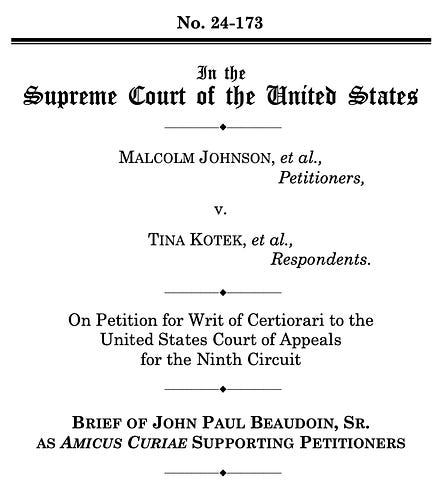
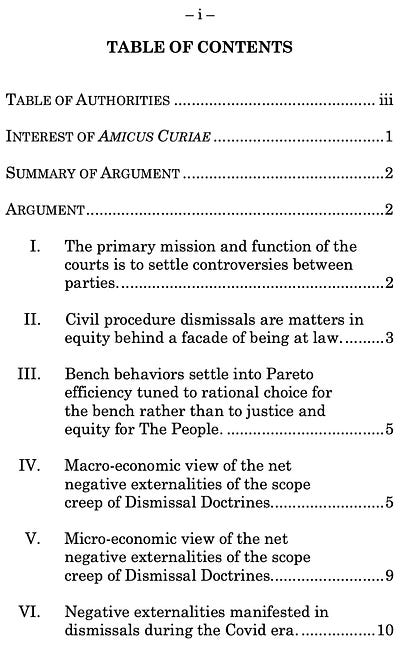
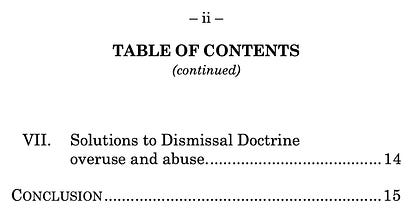
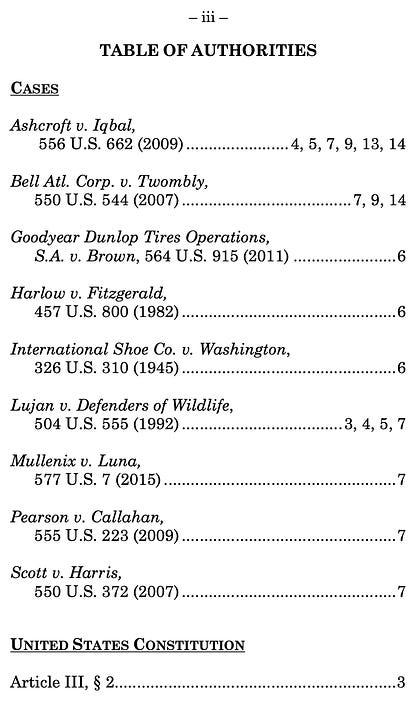
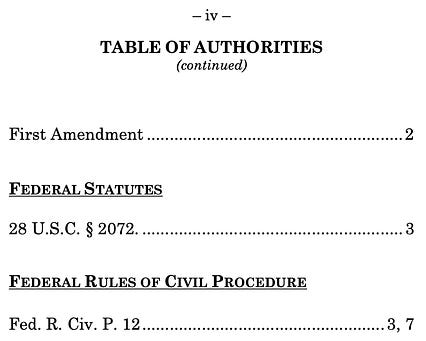
No comments:
Post a Comment